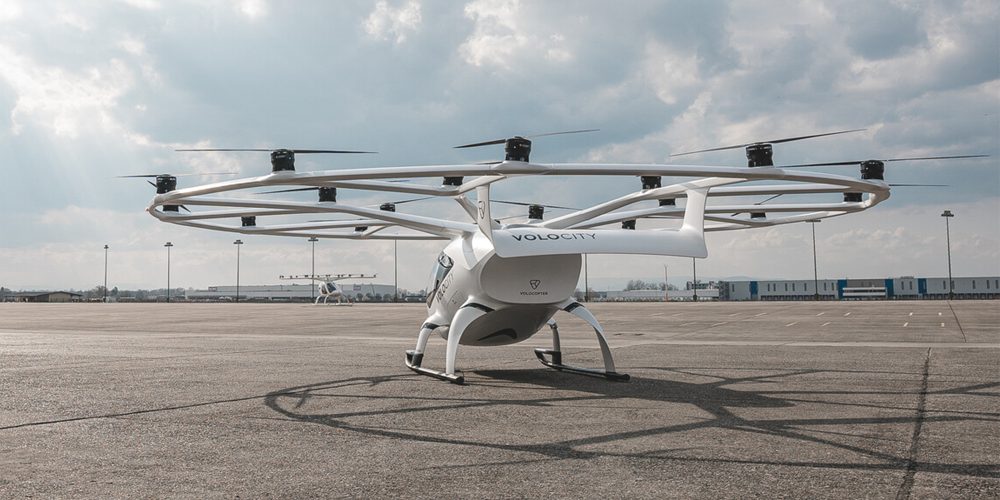
Volocopter, a specialist in urban air mobility (UAM), has announced that it has joined the Osaka Roundtable in order to promote its eVTOL (electric vertical take-off and landing) technology to Japan. Volocopter has also stated that it will demonstrate its flight technology at Expo 2025 Osaka Kansai.
The German company expects to launch public test flights of its eVTOL vehicles in Japan as early as 2023 ordered by Japan Airlines who invests in the Volocopter.
Moving on to the details of the deal, let us look at a few basic features of eVTOL.
What is eVTOL?
An electric vertical take-off and landing (eVTOL) aircraft use electric power to hover, take off, and land vertically. This technology came as a result of major advances in electric propulsion (motors, batteries, electronic controllers) and the growing need for new vehicles for urban air mobility (air taxis). They are a new type of clean, silent, and inexpensive air taxi that has the potential to completely revolutionize our cities in the coming decades.
Why eVTOLs?
When it comes to the concept of air taxis, eVTOLs make the most sense. There are several reasons eVTOLs are viewed to be the most feasible mode of short-distance air travel.
Some of the reasons are,
- The vertical take-off will eliminate the need for long impractical runways.
- No air pollution thanks to the electric propulsion system.
- Since they are powered electrically, the sound is considerably less.
- eVOLTs are economical than any other mode of air travel.
These reasons and many other reasons make eVTOLs the choice of the future.
The Commercial Phase
Volocopter, a German urban air mobility developer (UAM), has announced that it has joined the Osaka Roundtable in order to promote its eVTOL technology to Japan. Volocopter has also stated that it will demonstrate its flight technology at Expo 2025 Osaka Kansai. Volocopter expects to launch public test flights of its eVTOL vehicles in Japan as early as 2023, thanks to an order from Japan Airlines.
Volocopter combines the roles of the aircraft manufacturer, airport, and aerial pioneer. It has approximately 400 active workers and is backed financially by companies like Daimler and Japan Airlines (JAL).

The company was formed in Bruschel, Germany. The headquarters and three test and development locations for the company’s VoloCity air taxi are also located in the city.
Volocopter also has a facility in Munich, where it concentrates on the VoloDrone for large cargo transport and the development of the electric VoloConnect for longer flights.
In the future, Volocopter plans to deploy one of the world’s first eVTOL urban air taxi services in Singapore within the next three years. Within the next five years, the company also expects to supply 150 Volocopter devices to China’s Geely.
eVTOLs Might Takeoff by 2025 in Japan
Volocopter announced in a recent press release that it has participated in the Osaka Roundtable in Japan, with ambitions to bring its eVTOL technology to the country in a variety of ways.
The plan involves showcasing its UAM technology at Expo 2025 Osaka Kansai, an international exposition held every few years in locations all over the world. According to a press release from Volocopter, Japan has been working since 2018 to fully commercialize eVTOL air taxis and heavy-lift freight drones by 2030. These are two aerial products that Volocopter is working on.
Although 2025 may seem far away, Volocopter is already in contact with Japanese officials to assure the successful commercialization of UAM. In addition, the company indicated that it is in direct contact with local government authorities to discuss how its products may assist with disaster relief.
Looking ahead, Volocopter will continue to collaborate with Japanese regulators and the Osaka Roundtable to plan for 2023 and beyond, while also pursuing commercialized eVTOL flights in other regions of Asia, Europe, and possibly the United States.
The race for UAM is not a monopoly there are other players as well. Here is what Airbus has come up with.
Airbus Debuts New eVTOL Aircraft
At its Pioneering Sustainable Aerospace Summit on Sept. 21, Airbus unveiled CityAirbus NextGen, a new version of its CityAirbus electric vertical takeoff and landing (eVTOL) aircraft for the urban air mobility sector.
After years of development, the new CityAirbus NextGen follows the company’s demonstrator aircraft Vahana and CityAirbus. The NextGen version includes a V-shaped tail and fixed wings, as well as a dispersed propulsion system powered by eight electrically powered propellers. It will produce no emissions and be able to transport four people.
Airbus plans to debut their eVTOL, which will have a range of 80 kilometers and top speeds of 120 kilometers per hour. According to company executives, their design will allow them to complete 95%of targeting missions. By 2023, Airbus wants to test a prototype of the CityAirbus NextGen and they also estimate that certification will be achieved by 2025.